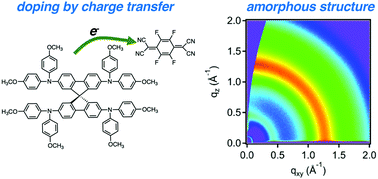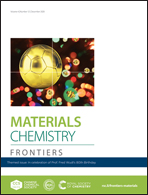Doping molecular organic semiconductors by diffusion from the vapor phase†
Abstract
Thin films of amorphous small molecule semiconductors are widely used in organic light emitting displays and have promising applications in solar cells and thermoelectric devices. Adding dopants increases the conductivity of organic semiconductors, but high concentrations of dopants can disrupt their structural ordering, alter the shape of the electronic density of states in the material, and increase the effects of Coulomb interactions on charge transport. Electrical doping of the solution processable hole-transport material 2,2′,7,7′-tetrakis[N,N-di(4-methoxyphenyl)amino]-9,9′-spirobifluorene (spiro-OMeTAD) was studied with 2,3,5,6-tetrafluoro-7,7,8,8-tetracyanoquinodimethane (F4TCNQ) as a p-type dopant. Infiltration of F4TCNQ from the vapor phase into films of spiro-OMeTAD provided a route to highly doped films with up to 39 ± 2 mol% doping. Structural characterization confirmed that the films remain amorphous even at the highest doping levels with no apparent phase separation. We quantitatively determined the carrier concentration using UV-Vis spectroscopy to interpret the evolution of the electrical conductivity. Over the range of carrier concentrations (1019–1020 1 cm−3), the electrical conductivity increased no more than linearly with carrier concentration, while the thermopower had a small increase with carrier concentration. The trends in conductivity and thermopower were related to the unique electronic structure of spiro-OMeTAD, which is able to support two carriers per molecule. Temperature-dependent conductivity measurements were used to further analyze the transport mechanism.

- This article is part of the themed collection: Celebrating Prof. Fred Wudl’s 80th Birthday


 Please wait while we load your content...
Please wait while we load your content...
